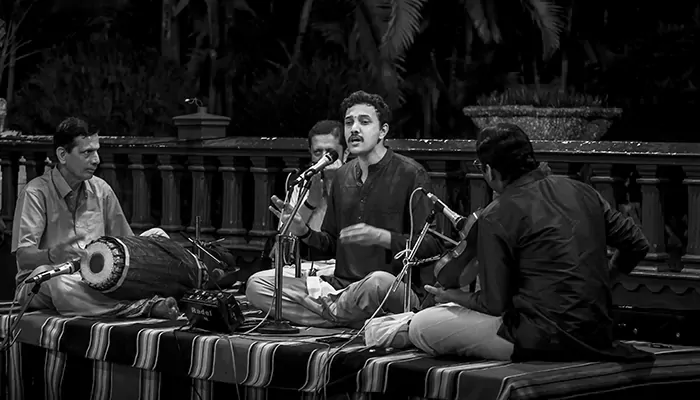
Discover how Bombay's elite risked it all, hosting clandestine concerts where soaring ragas became anthems for freedom.
Picture Bombay in the 1940s. The air crackles with tension. World War II rages, but closer to home, India's own fierce battle for independence is reaching boiling point. Public protests? Often met with brute force. Open dissent? Dangerous. But the desire for swaraj (self-rule) couldn't be silenced. It found a surprising, beautiful outlet: the private drawing rooms of the city's wealthy. This wasn't just entertainment; it was a secret symphony for freedom.
When the British Raj clamped down hard - especially after the explosive Quit India Movement of 1942 - open nationalist activities became near impossible. Big public concerts with overtly patriotic themes? Forget it. That’s when a clever, courageous workaround emerged. Influential families - industrialists, lawyers, academics - started hosting exclusive musical soirees in their grand homes. Think Malabar Hill, Cumballa Hill. Plush carpets, maybe the scent of jasmine garlands and a revolutionary spirit humming beneath the surface.
Suraiya and Nargis - the two superstars of the 1940s & 50s - both residents of Marine Drive Bombay, within a few minutes walk of each other. pic.twitter.com/Mw4bTgZloS
— Film History Pics (@FilmHistoryPic) November 4, 2018
This photo of Suraiya - a prominent singer and actress, and Nargis - captures the cultural elite of Bombay, providing a visual representation of the era's artistic community.
(@FilmHistoryPic/X)
These weren't just concerts. They were carefully curated acts of resistance. The genius lay in the programming. On the surface? A perfectly respectable classical music performance. The finest ustads and pandits would be invited - legends like Omkarnath Thakur, D.V. Paluskar, Kesarbai Kerkar, or the formidable duo of Aman Ali Khan and Ayam Ali Khan (the Bhendi Bazaar brothers).
5.) 1897: Hindustani classical maestro Omkarnath Thakur born. pic.twitter.com/mc9I9Izv3D
— The India Info (@theindiainfocom) June 24, 2025
Pandit Omkarnath Thakur
(@theindiainfocom/X)
The program would feature beautiful, intricate ragas. But woven subtly, almost invisibly, into the fabric of the performance were powerful, patriotic gems. Imagine the soul-stirring strains of Vande Mataram emerging seamlessly after a majestic alap in Raga Desh. Or a poignant thumri carrying the pain of a nation yearning for freedom. Songs like Sare Jahan Se Achha or Kadam Kadam Badhaye Ja weren't blasted from speakers; they were whispered through the artistry of the masters, resonating deeply with the knowing audience. Everyone understood the code. The music itself became a secret language of defiance.
Kesarbai Kerkar 🎵🌹 pic.twitter.com/N8HM4kp0eD
— AfghanrecordsGallery (@AfghanrecordsG) July 27, 2023
Kesarbai Kerkar - Indian Classical Vocalist of the Jaipur-Atrauli gharana.
(@AfghanrecordsG/X)
Here’s where it got really clever. Attending these concerts wasn't free. Entry required a hefty "donation." We're talking hundreds, sometimes even thousands of rupees - a fortune back then! This wasn't about profiting; it was pure, concentrated fundraising. The hosts, often prominent Congress supporters or sympathizers themselves, channeled every single rupee straight into the freedom movement's coffers. This money was lifeblood. It funded underground newspapers that spread the truth when the British censored everything. It supported families of imprisoned freedom fighters who faced hardship. It helped organize the very networks keeping the resistance alive. That elegant evening of music was, quite literally, fueling the revolution.
Inside a room full of Bombay's elite, hearts pound with a shared purpose. Every subtle patriotic inflection in the music, every knowing glance exchanged, was a tiny act of rebellion. There was risk involved too. If the authorities caught wind of the real agenda? Raids, arrests, imprisonment were very real possibilities. Yet, people came. They listened. They donated. They defied.
(1940s) 'Mallika-e-Ghazal' Begum Akhtar during a live performance. pic.twitter.com/rSOpNhcwOI
— Film History Pics (@FilmHistoryPic) July 23, 2017
Ghazal, dadra and thumri legend Begum Akhtar
(@FilmHistorypic/X)
These hidden concerts were more than just fundraisers. They were vital morale boosters in a dark time. They kept the flame of patriotism alive within a section of society that had influence and resources. They proved that the fight for freedom wasn't just fought on the streets with slogans, but also in the cultured spaces of society with the profound power of music. They showed how art could become a weapon, how culture could nurture courage.
When India finally won its hard-earned independence in 1947, the echoes of those secret symphonies surely rang out with a special sweetness. The ragas sung behind closed doors, the money quietly passed along, the shared hope in those plush drawing rooms - it all played a crucial, if often unsung, part in the incredible story of a nation finding its voice.
It was Bombay's unique, harmonious contribution to the freedom struggle, proving that sometimes, the most powerful revolutions begin not with a shout, but with a perfectly pitched note.